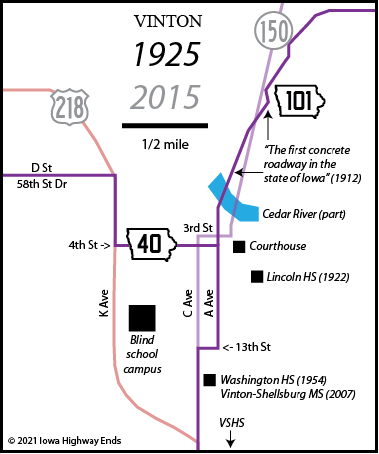Vinton is a larger town than you might think. By that, I mean it has a population above 5,000, but because the highways are only in the west and middle, much of it is residential areas where travelers don’t go. (I include myself in that group, given the umpteen dozen times I’ve gone through.)
I thought I had pegged the 1920 route of IA 40 pretty easily, as the pre-bypass that skirted the west side of its original core downtown on C Avenue and 4th Street. However, a recently digitized document at the Iowa DOT website, filed under “early roads”, disproved that. It turns out that like with other cities’ business districts at the time, “close” took a back seat to “through”. Instead of C, 40 used A Avenue, two blocks east.

A three-paragraph item in the Cedar Valley Daily Times May 22, 1929, says:
The C Avenue project is on highway 218 and will connect with 4th street on the north and 13th street on the south, which, with the paving now in progress connecting up Vinton to La Porte City, completes the surfacing of No. 218 through Benton county, with the exception of the few rods at the Milwaukee track crossing south of Vinton, which have been proved with a temporary crushed rock surface.
At the time, 13th Street was the south side of town. South of there, though, part of the way to the Lincoln Highway was paved in 1921, and the rest in the fall of 1927. (The same contractor that paved in August 1921 immediately went south to Belle Plaine, where a short stretch of concrete Lincoln Highway opened Nov. 12.)
In the 1920s, cities and not the state controlled where routes went within city limits. Therefore, I wouldn’t be able to point to a change date unless it’s mentioned in the newspaper archives, which it is not. What I can say is that in 1920, IA 40 used A Avenue, and by the end of 1929, US 218 used C Avenue.
This re-evaluation of IA 40 also changes the 1920 endpoints of IA 58 and IA 101. The former’s redundant multiplex from the IA 8 intersection was dropped in 1924. The latter, with this new information, now first ended on southbound A Avenue at 4th Street, where a driver could continue ahead on southbound 40 or turn right on northbound 40. The information on the IA 58 (1920) and IA 101 pages has been changed accordingly, along with explanation of the 2012 picture’s position.
